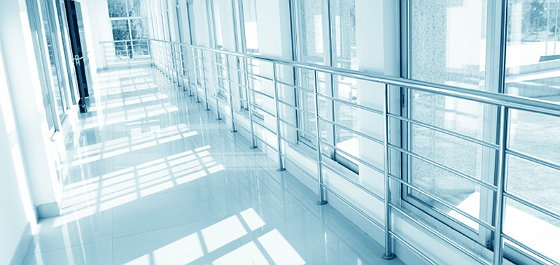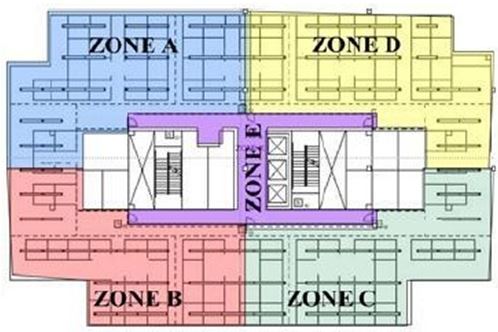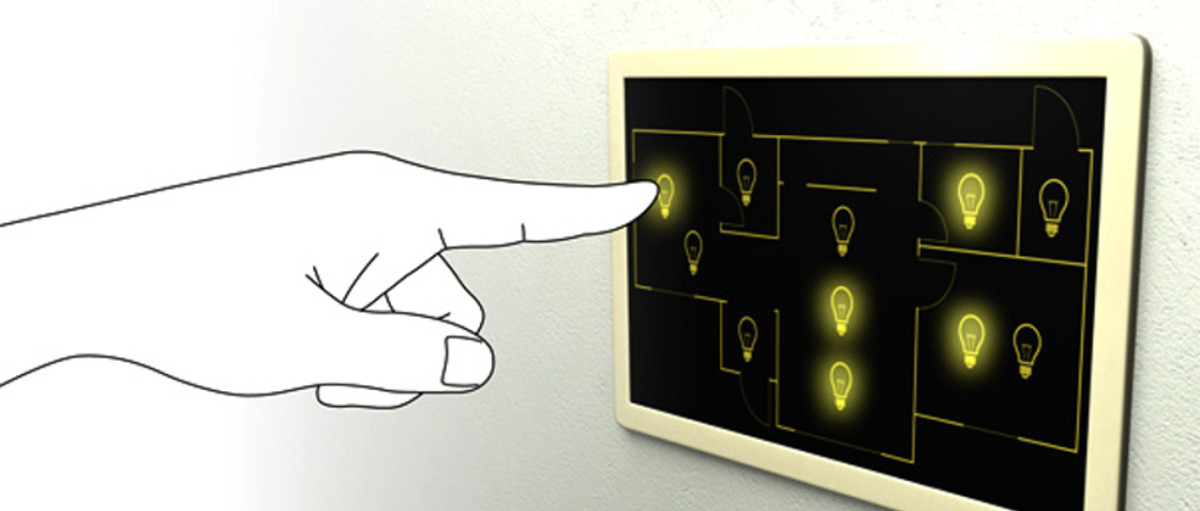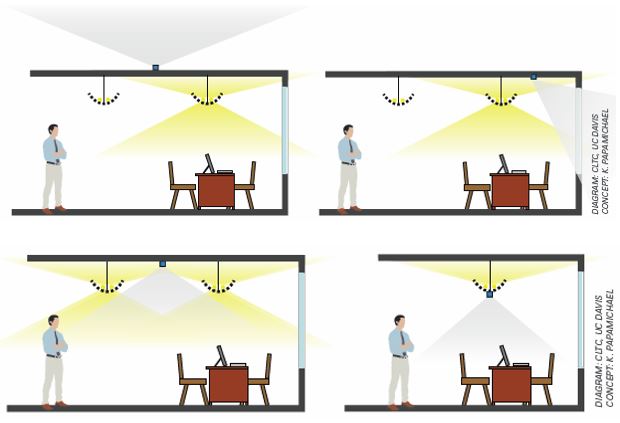PoE Lighting and daylight harvesting, or daylight response, is an automatic lighting control strategy in which interior lighting adjusts to maintain a target lux level, in order to reduce energy costs. It is most effective in areas that consistently receive ample daylight, such as lighting adjacent to windows or near skylights.
Establish daylight zones
The first step is to identify lighting in areas of daylight availability, which can be controlled using daylight harvesting. The majority of energy codes require daylight harvesting and establish minimum zoning dimensions.
In some spaces, there may be two daylight zones: the primary zone directly  adjacent to the daylight aperture, and the secondary zone adjacent to the primary zone. This is to differentiate daylight contribution and response.
adjacent to the daylight aperture, and the secondary zone adjacent to the primary zone. This is to differentiate daylight contribution and response.
General lighting in these zones is controlled independently of other general lighting in the same space, with the Luminetworx Lighting control system responding to daylight contribution to light levels.
 Daylight zone in a typical windowed space, defined here as penetrating into the space a distance of 2 times the window height.
Daylight zone in a typical windowed space, defined here as penetrating into the space a distance of 2 times the window height. Place the lighting
Daylight generally produces ambient illumination, thereby contributing to general lighting. In some spaces, daylight intensity declines with distance from the daylight aperture (window, skylight), resulting in gradients radiating from it.
For this reason, PoE Light Fixtures may be arranged in individually controlled rows or groups (zoning) parallel to the daylight aperture.
Establish the control zones
Lighting control zones are fixtures controlled simultaneously by a single control output. All lights in a daylight zone may be zoned to a single control output, or the lights may be grouped in smaller zones or controlled individually for greater control responsiveness and typically higher energy savings.
Choose the control method
Next is to decide how the lighting system will respond to rising light levels. Control choices include basic ON/OFF, stepped switching, stepped dimming, and continuous dimming.
Basic switches are suited for circulation spaces such as lobbies and corridors. With basic switching, the lighting control system turns all PoE Lighting OFF when the light level reaches a target set-point (mechanical switch, timer, motion sensor).
Dimming is for spaces with stationary tasks, such as open offices. With stepped dimming, all PoE lights undergo a stepped light reduction, which may involve independently controlled lamps/arrays, or dimming to one of several preset light outputs. Continuous dimming is the same as stepped dimming but with at least 10 steps, resulting in more flexibility.
stepped dimming, all PoE lights undergo a stepped light reduction, which may involve independently controlled lamps/arrays, or dimming to one of several preset light outputs. Continuous dimming is the same as stepped dimming but with at least 10 steps, resulting in more flexibility.
The widespread availability of PoE lighting offers dimming capability that can be leveraged for daylight harvesting. For example, the fixtures could be dimmed to a very low level rather than turned OFF, which can reduce potential confusion among users thinking the lights are malfunctioning instead of purposely turned OFF.
The right technology
To respond to daylight, the control system has to “see” it or otherwise predict it will be present. Photosensors are considered the most reliable because daylight availability may be highly variable.
For photosensors, important considerations are spectral and directional sensitivity, and open- or closed-loop operation. Sensitivity should be properly matched to the application, which accounts for light levels in different areas types. Closed-loop sensing detects light falling on the sensor from both daylight and electric lighting, while open-loop sensing detects daylight only. Closed-loop sensors typically install indoors facing away from the daylight aperture, while open-loop sensors typically install facing the source of daylight. 
Commission the system
This involves verifying the fixture types, placement, and zoning to controls; verifying installation and proper operation of controls; tuning the controls; and verifying proper control operation in response to light level changes.
Harvesting daylight
Daylight harvesting remains a viable lighting control strategy and a key mandatory requirement in prevailing commercial building energy codes.
To find out more about the Luminetworx PoE Lighting Solution contact us now.



1 Comment
[…] the cost of ownership is even lower. When integrated with the lighting controls motion sensors, daylight harvesting, scheduling and scenes energy use and efficiency can be maximized to provide the lowest operating […]